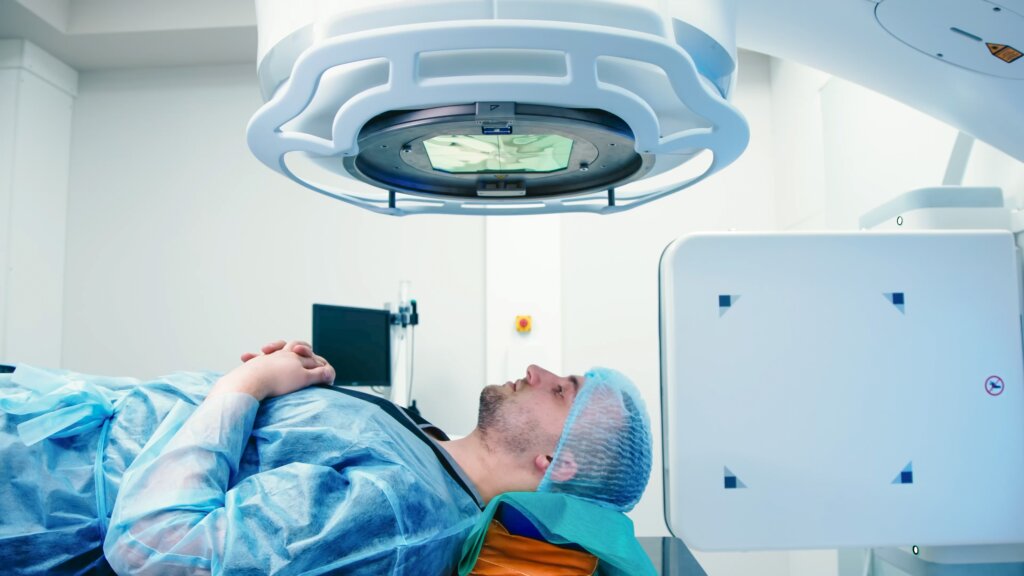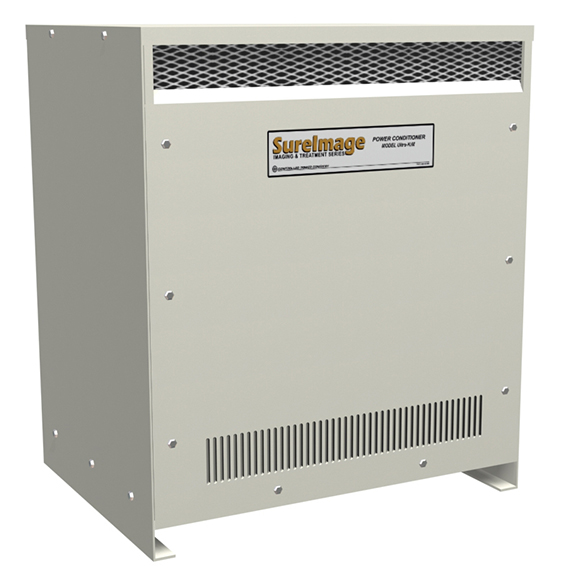Medical imaging systems place extraordinary demands on electrical infrastructure. During scans or treatment cycles, many modalities (or types of imaging equipment) experience current surges that can reach 3 to 5 times their steady-state voltage draw. These brief, high-intensity events often last less than five seconds, but require a power source capable of delivering large amounts of current without allowing voltage to sag beyond equipment tolerances.
To compensate, some equipment manufacturers and facility engineers take a conservative approach, oversizing distribution transformers and feeder cables to accommodate the maximum anticipated load. While effective in limiting voltage drop during scan mode, this strategy results in costly and inefficient installations … especially since imaging systems operate in standby mode most of the time, drawing only a fraction of their peak power. A more efficient solution lies in using UL Listed, K(i) rated power conditioning transformers or voltage regulators. These systems are engineered to manage the rapid current fluctuations typical of medical imaging equipment, supplying the necessary momentary power while maintaining voltage stability. In doing so, K(i) rated solutions deliver both performance and efficiency … thus meeting the exacting demands of healthcare environments without unnecessary oversizing or wasted energy.
This article dives a bit deeper into what exactly is a K(i) rating, as well as:
- The design and performance of K(i) rated systems.
- The results of poor power quality in medical imaging.
- The benefits of Trystar solutions to both the medical facility AND its patients.

Example of a linear accelerator used in radiation oncology treatment.
What Is A K(i) Rating?
A K(i) rating quantifies a transformer’s capacity to manage elevated levels of harmonic currents and nonlinear loads, which are prevalent in advanced electronic medical equipment. In healthcare settings, these complex load profiles are produced by imaging systems such as X-Ray, MRI, CT, and PET scanners … systems characterized by rapid cycling between minimal standby current and substantial inrush (or “scan current”) during the operation of the equipment. The resulting current fluctuations and harmonic distortion place significant thermal and electrical stress on power distribution infrastructure.
A K(i) rated transformer is specifically engineered to maintain precise voltage regulation and endure transient current surges without excessive temperature rise or waveform distortion. Unlike conventional K-rated transformers designed for general commercial or industrial use, K(i) rated transformers undergo rigorous testing and certification to meet stringent medical-grade standards as defined by UL and IEC guidelines. This ensures not only regulatory compliance but also optimal performance and enhanced patient safety by minimizing the risk of power anomalies that could compromise sensitive diagnostic equipment.

K(i) rated transformers safeguard both equipment integrity and the physical safety of clinicians and patients by ensuring stable, distortion-free power for critical medical imaging systems, minimizing the risk of equipment malfunction or failure during diagnostic procedures.
Design And Performance Of K(i) Rated Systems
K(i) rated power conditioners and voltage regulators are engineered to accommodate the highly dynamic electrical load profiles characteristic of modern medical imaging equipment. Their transformers utilize advanced winding topologies, low-impedance isolation techniques, and precision voltage regulation circuitry to ensure stable output voltage and minimal harmonic distortion, even during abrupt load transitions.
When a CT or MRI scanner shifts from standby to active scan mode, the K(i) rated transformer rapidly responds to the resulting high inrush current by dynamically adjusting its magnetic flux and maintaining tight voltage regulation. This capability ensures the delivery of clean, stable power within strict voltage tolerances, thereby supporting consistent imaging quality, prolonging the operational lifespan of sensitive medical devices, and reducing the likelihood of nuisance faults / trips or unplanned system resets.
By contrast, oversized transformers address load variability primarily through increased capacity rather than precise control, often resulting in operational inefficiencies such as elevated core losses, excessive thermal output, and higher capital and operating costs. K(i) rated systems achieve superior or equivalent performance by leveraging optimized electromagnetic design and targeted harmonic mitigation, rather than relying on excessive transformer sizing.
The Results Of Poor Power Quality In Medical Imaging
Suboptimal power quality can result in significant clinical and financial repercussions. Voltage sags, harmonic distortion, and transient voltage spikes introduce electrical noise and instability that can compromise image resolution, introduce “artifacts” (specks and blotches) into the digital image, disrupt scan sequences, and trigger equipment protection faults. Each power-related interruption translates to lost imaging throughput, increased likelihood of patient rescheduling, and potential delays in diagnoses or treatments.

Neurologists evaluating MRI brain scans. Poor image quality due to voltage
anomalies can compromise image resolution and lead to inaccurate diagnoses.
Beyond downtime, poor power quality accelerates wear on critical imaging components such as X-Ray tubes, gradient amplifiers, and digital processors. Chronic exposure to electrical anomalies increase thermal and electrical stress on these components. Over time, this leads to higher maintenance costs, premature equipment failures, and shortened system lifespans … all of which are outcomes that strain both operational budgets and patient care schedules. These outcomes impact both the cost efficiency and clinical service delivery of the healthcare facility.

Poor power quality translates into:
- “Artifacts” in the digital image.
- Random error codes and system lock-ups.
- Costly repeat scans.
- Unexplained system faults or restarts.
- Unscheduled downtime and expensive emergency repairs.
The Trystar Solution
Trystar’s UL Listed K(i) rated power conditioning solutions include the Ultra-K/M Three Phase Isolation Transformer and the Model 700F/M Three Phase Voltage Regulator with Isolation. Each solution delivers clean, stable power for healthcare imaging environments. With a combination of precise voltage regulation, harmonic mitigation, and thermal management, these solutions meet the unique electrical demands of MRI, CT, PET, and other imaging systems.
Significant Benefits of the Ultra-K/M Three Phase Isolation Transformer
- Provides true isolation between primary and secondary windings, improving noise rejection and equipment protection.
- Maintains stable voltage during rapid load transitions, ensuring consistent imaging performance.
- Reduces harmonic distortion and limits neutral-to-ground voltage.
- Compact design minimizes footprint and installation cost.
- Built and tested to UL medical-grade standards, ensuring compliance and reliability in patient care environments.
- Significant reduction / elimination of “artifacts” in the digital image.
- Enhanced workflow and processing time.
- Prevents premature failure of imaging / treatment equipment.
- Reduced installation expenses, lower operating costs, greater efficiency, and lower cost to maintain the imaging / treatment equipment.

Model Ultra-K/M Three Phase Isolation Transformer
75 K(i) – 225 K(i)
Significant Benefits of the Model 700F/M Three Phase Voltage Regulator, with Isolation
- Offers ±1% tight line voltage regulation under dynamic load conditions.
- Responds within milliseconds to compensate for sudden current surges during imaging operation.
- Provides galvanic isolation for superior electrical noise suppression.
- Enhances power factor and overall energy efficiency.
- Designed for long-term reliability, reducing downtime and maintenance costs in mission-critical imaging suites.
- Highest level of image quality and diagnostic reliability.
- Removal of voltage sags / surges associated with system restarts.
- Optimum workflow and patient satisfaction.

Model 700F/M Three Phase Voltage Regulator With Isolation
60 K(i) – 260 K(i)

Trystar’s UL Listed K(i) rated power conditioning solutions ensure the safe and reliable operation of critical medical imaging modalities by delivering clean, stable, and isolated power … all of which protect both the medical equipment, as well as the physical safety of clinicians and patients.
Image quality and clinician / patient satisfaction are by design … not by accident. Connect with one of our solutions team members today … discover how Trystar’s K(i) rated power solutions ensure reliable, efficient performance for today’s most demanding medical imaging systems!